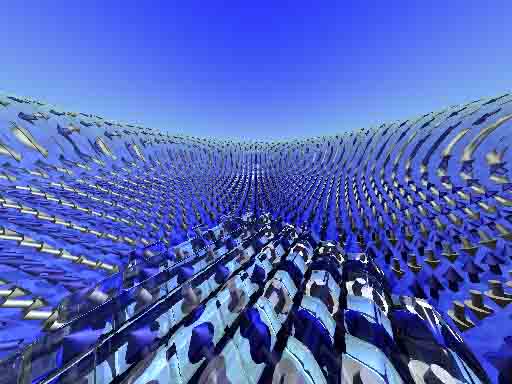| Mott Transition | Mott Physics | Frustrated Magnet | Spin Chain | Metallic Ferromagnetism | Magnetic Transition | Theoretical Approaches |
 Even at the filling where band theory predicts a metal, the system can be insulating due to Coulomb interactions between electrons. This type of metal-insulator transition is called the Mott transition, whose properties have been discussed for a long time since the late 1940s. In particlular, since the cuprate high-temperature superconductors are obtained by doping antiferromagnetic Mott insulators with layered structures, electronic properties near the Mott transision in a two-dimensional (2D) system have attracted much attention, and various possibilities have been theoretically proposed, such as the first-order phase transition, divergence of the effective mass in a Fermi liquid, band-insulator-type transition from an antiferromagnetically ordered metal, and slave particle pictures.
Even at the filling where band theory predicts a metal, the system can be insulating due to Coulomb interactions between electrons. This type of metal-insulator transition is called the Mott transition, whose properties have been discussed for a long time since the late 1940s. In particlular, since the cuprate high-temperature superconductors are obtained by doping antiferromagnetic Mott insulators with layered structures, electronic properties near the Mott transision in a two-dimensional (2D) system have attracted much attention, and various possibilities have been theoretically proposed, such as the first-order phase transition, divergence of the effective mass in a Fermi liquid, band-insulator-type transition from an antiferromagnetically ordered metal, and slave particle pictures.
 Mott transition of the one-dimensional Hubbard model [1]
Mott transition of the one-dimensional Hubbard model [1]
Fig. 1 (a) Single-particle spectral function of the 1D Hubbard model near the Mott transtion [1]. (b) Schematic picture of the dominant modes near the Mott transition. Toward the Mott transiton, the mode for ω > 0 (dotted pink curve) reduces to the spinon dispersion relation indicated by the solid red curve, which is symmetrical with the spinon dispersion relation for ω < 0 with respect to the gapless point at k = kF. Even in the zero-doping limit, it does not become flat [1]. The spectral weight of the mode gradually disappears toward the Mott transition. The region between the two gapless points [intersections of the anti-holon mode (dotted yellow curve for ω > 0) and ω = 0 (solid green line)] can be regarded as a hole pocket, which shrinks as the Mott transition is reached [1]. (c) Dispersion relations of a doped band insulator. (d) Schematic picture of single-particle density of states of a Fermi liquid with divergent effective mass m*. The effective bandwidth shrinks as m* → ∞. Solid green lines indicate ω = 0.
 Mott transition of the two-dimensional Hubbard model [2]
Mott transition of the two-dimensional Hubbard model [2]
In addition, I am interested in critical behaviors [7] and enhancement of superconductiviting correlations [8] near the Mott transition.
[Related papers]
-
"Spectral Properties near the Mott Transition in the One-Dimensional Hubbard Model",
Masanori Kohno,
Physical Review Letters 105, 106402 (2010). -
Masanori Kohno,
"Mott transition in the two-dimensional Hubbard model",
Physical Review Letters 108, 076401 (2012). -
Masanori Kohno,
"States induced in the single-particle spectrum by doping a Mott insulator",
Physical Review B 92, 085129 (2015). -
Masanori Kohno,
"Characteristics of the Mott transition and electronic states of high-temperature cuprate superconductors from the perspective of the Hubbard model",
Reports on Progress in Physics 81, 042501 (2018). -
Masanori Kohno,
"Spectral properties near the Mott transition in the two-dimensional t-J model",
Physical Review B 92, 085128 (2015). -
Masanori Kohno,
"Spectral properties near the Mott transition in the two-dimensional Hubbard model with next-nearest-neighbor hopping",
Physical Review B 90, 035111 (2014). -
Masanori Kohno,
"Spectral properties near the Mott transition in the two-dimensional t-J model with next-nearest-neighbor hopping",
Physica B: Condensed Matter 536, pp.447--449 (2018). -
Masanori Kohno,
"Relationship between Single-Particle Excitation and Spin Excitation at the Mott Transition",
JPS Conference Proceedings 3, 013020 (2014). -
Masanori Kohno,
"Doping-induced states in the single-particle spectrum originating from magnetic excitation of a Mott insulator",
Physics Procedia 75, pp.206--213 (2015). -
"Ground-state properties of the two-dimensional t-J model",
Masanori Kohno,
Physical Review B 55, pp.1435-1441 (1997). -
"Enhancement of Pairing Correlations and Spin Gap through Suppression of
Single-Particle Dispersion in One-Dimensional Models",
Masanori Kohno, and Masatoshi Imada,
Journal of the Physical Society of Japan 69, pp.25-28 (2000).